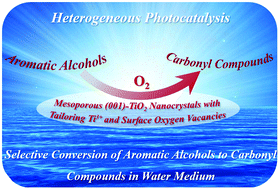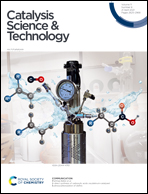Mesoporous (001)-TiO2 nanocrystals with tailored Ti3+ and surface oxygen vacancies for boosting photocatalytic selective conversion of aromatic alcohols†
Abstract
Selective conversion of aromatic alcohols to value-added chemicals is becoming an emerging research hotspot in heterogeneous photocatalysis, but its critical challenge is how to construct highly efficient photocatalysts. Herein, mesoporous (001)-TiO2 nanocrystals with tailored Ti3+ and surface oxygen vacancies have been fabricated by a facile hydrothermal route, showing remarkably boosted photoactivity for selective conversion of aromatic alcohols to carbonyl compounds in water medium under visible-light irradiation. Results attest that the remarkably boosted photoactivity was mainly correlated with the strong synergetic effect of exposed (001) facets, Ti3+ self-doping, and surface oxygen vacancies, leading to the enhanced reactant (aromatic alcohols and O2) activation via the high surface energy of (001) facets, the improved visible-light absorbance via the intrinsic band gap narrowing, and the escalated photoelectron–hole separation efficiency via Ti3+ and surface oxygen vacancies acting as electron sinks. Meanwhile, a plausible photocatalytic mechanism for selective conversion of aromatic alcohols to carbonyl compounds has been elucidated in detail based on active species identified by capture experiments. It is hoped that this work can deliver some new insights into the rational design of highly efficient photocatalysts applied in future green organic selective transformation reactions.



 Please wait while we load your content...
Please wait while we load your content...